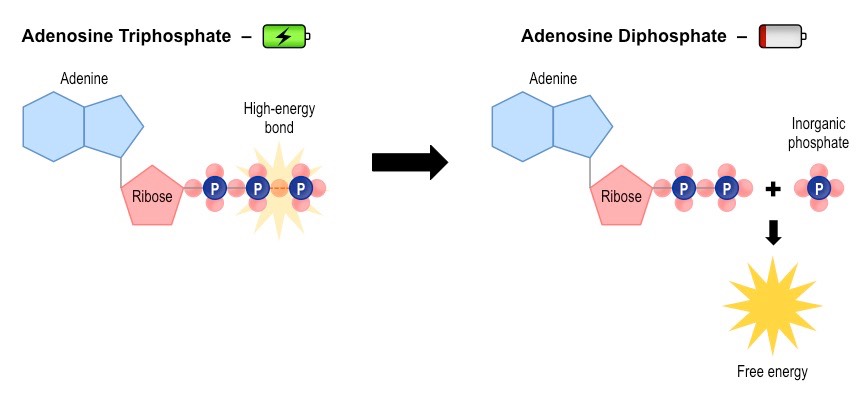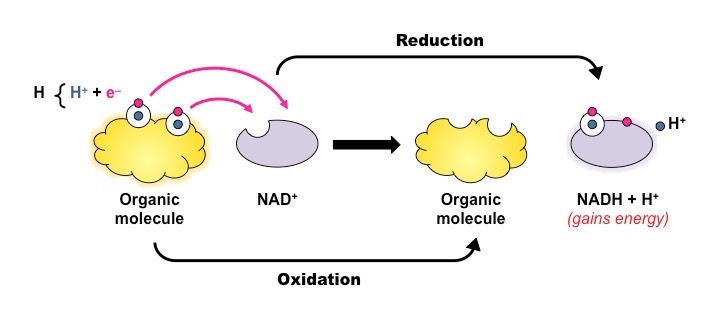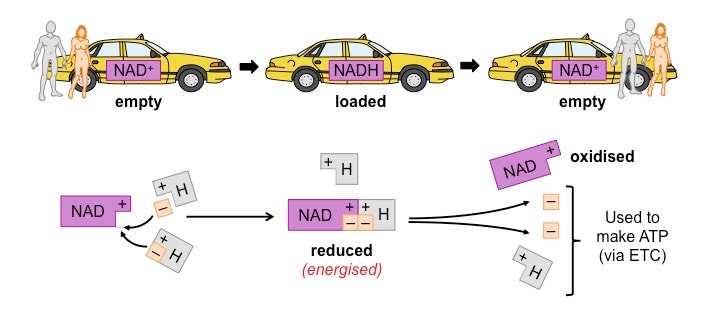![]()
Understanding:
• Phosphorylation of molecules makes them less stable
Adenosine triphosphate (ATP) is a high energy molecule that functions as an immediate power source for cells
- One molecule of ATP contains three covalently bonded phosphate groups – which store potential energy in their bonds
- Phosphorylation makes molecules less stable and hence ATP is a readily reactive molecule that contains high energy bonds
- When ATP is hydrolysed (to form ADP + Pi), the energy stored in the terminal phosphate bond is released for use by the cell
Relationship between ATP and ADP

ATP has two key functions within the cell:
- It functions as the energy currency of the cell by releasing energy when hydrolysed to ADP (powers cell metabolism)
- It may transfer the released phosphate group to other organic molecules, rendering them less stable and more reactive
ATP is synthesised from ADP using energy derived from one of two sources:
- Solar energy – photosynthesis converts light energy into chemical energy that is stored as ATP
- Oxidative processes – cell respiration breaks down organic molecules to release chemical energy that is stored as ATP
![]()
Understanding:
• Cell respiration involves the oxidation and reduction of electron carriers
Cell respiration is the controlled release of energy from organic compounds to produce ATP
- Anaerobic respiration involves the incomplete breakdown of organic molecules for a small yield of ATP (no oxygen required)
- Aerobic respiration involves the complete breakdown of organic molecules for a larger yield of ATP (oxygen is required)
The breakdown of organic molecules occurs via a number of linked processes that involve a number of discrete steps
- By staggering the breakdown, the energy requirements are reduced (activation energy can be divided across several steps)
- The released energy is not lost – it is transferred to activated carrier molecules via redox reactions (oxidation / reduction)
Energy Conversions in Sugar Breakdown (Direct Combustion vs Cell Respiration)

Redox Reactions
When organic molecules are broken down by cell respiration, the chemical energy is transferred by means of redox reactions
- Redox reactions involved the reduction of one chemical species and the oxidation of another (redox = reduction / oxidation)
Most redox reactions typically involve the transfer of electrons, hydrogen or oxygen
- Reduction is the gain of electrons / hydrogen or the loss of oxygen
- Oxidation is the loss of electrons / hydrogen or the gain of oxygen
Redox reactions can be summarised according to the following table:

Redox Mnemonics
Redox reactions involving electrons can be remembered using any of the following mnemonics:
- OIL RIG – Oxidation Is Loss (of electrons) ; Reduction Is Gain (of electrons)
- LEO goes GER – Loss of Electrons is Oxidation ; Gain of Electrons is Reduction
- ELMO – Electron Loss Means Oxidation

![]()
Understanding:
• Energy released by oxidation reactions is carried to the cristae of the mitochondria by reduced NAD and FAD
Cell respiration breaks down organic molecules and transfers hydrogen atoms and electrons to carrier molecules
- As the organic molecule is losing hydrogen atoms and electrons, this is an oxidation reaction
- Energy stored in the organic molecule is transferred with the protons and electrons to the carrier molecules
The carrier molecules are called hydrogen carriers or electron carriers, as they gain electrons and protons (H+ ions)
- The most common hydrogen carrier is NAD+ which is reduced to form NADH (NAD+ + 2H+ + 2e– → NADH + H+)
- A less common hydrogen carrier is FAD which is reduced to form FADH2 (FAD + 2H+ + 2e– → FADH2)
The hydrogen carriers function like taxis, transporting the electrons (and hydrogen ions) to the cristae of the mitochondria
- The cristae is the site of the electron transport chain, which uses the energy transferred by the carriers to synthesize ATP
- This process requires oxygen to function, and hence only aerobic respiration can generate ATP from hydrogen carriers
- This is why aerobic respiration unlocks more of the energy stored in the organic molecules and produces more ATP
Energy Transfer via Hydrogen Carriers


⇒ Click on the diagram to display taxi representation
